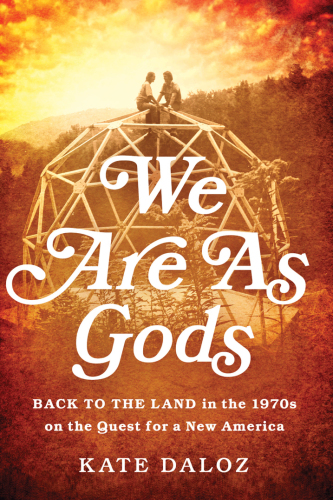
We Are As Gods
Back to the Land in the 1970s on the Quest for a New America
کتاب های مرتبط
- اطلاعات
- نقد و بررسی
- دیدگاه کاربران
نقد و بررسی

June 13, 2016
In this deep study, Daloz, who grew up in a back-to-the-land community in Vermont, looks at how these communities rose and fell, as well as where they succeeded and went awry. In the 1970s, thousands of Americans abandoned urban areas to establish communes where they lived off the land, embracing a hippie or idyllist lifestyle and looking to return to a more naturalistic, peaceful existence. "The 1970s remain the only time in the nation's history when more people moved to rural areas than into the cities," Daloz writes, "reversing two hundred years of steady urbanization." This trend was a callback to the utopian communities and experimental societies of the 18th and 19th centuries, and it helped to define a generation. By focusing much of the narrative on a group called Myrtle Hill Farm, Daloz gives an intimate look into their social dynamics and experiences, putting names and faces on the ambitions, hopes, and failures of the back-to-the-land movement. Daloz's voice is distant and lacks passion, keeping the reader at bay despite a wealth of details granted through experience and interviews. Still, this is an informative look at an era that laid the groundwork for the modern organic movement and its relatives. Agent: Kris Dahl, ICM.

If you can remember the '60s, you may have been there--but as a very young person, as this thoughtful history reveals. Joni Mitchell once said that we've got to get back to the garden, and tens of thousands heeded; in the years surrounding Woodstock, communes sprouted like mushrooms across America. Born to back-to-the-landers but now a denizen of Brooklyn, Daloz writes with firsthand knowledge of the good and bad of these wishfully self-reliant places. The good is obvious: young people built rural lives away from the urban grind, reinvigorating the countryside and laying the foundation for our current devotion to organic and healthy foods. The manifold bad included culture clashes with rural people: "Hippie newcomers," writes the author, "sometimes fell afoul of locals by not understanding--or ignoring--essential customs." Communes were also subject to old-fashioned sexism imported from home, with the women doing the brunt of the work unappreciated, and to invasion by bikers, dealers, addicts, runaways, and drifters, adding to the tension and instability. Among Daloz's case studies are The Farm, still thriving in Tennessee, and Drop City, the Colorado commune celebrated in T.C. Boyle's novel of the same name, built on the "philosophy that it was possible, amid the extravagant excess of American society, to live richly and well on others' refuse." A literary scholar and teacher, Daloz also examines the long history of communitarianism in America, reflected in the works of Henry David Thoreau, Nathaniel Hawthorne, and other writers. She carries her investigations into the present, noting that even though the heyday of the 1960s and '70s commune movement has long passed, the ethos endured, with "radical social experiments in group living...replaced by individual families' radical experiments in self-sufficiency--including my family's." Well written and full of firsthand insight--a good companion to weightier studies such as Timothy Miller's The 60s Communes (1999) and Arthur Kopecky's Leaving New Buffalo Commune (2006). COPYRIGHT(1) Kirkus Reviews, ALL RIGHTS RESERVED.

May 1, 2016
In this engaging book, Daloz (writing center, Baruch Coll.) interweaves the stories of several communes in Vermont in the 1970s with the tale of her own childhood, when her parents shared ownership of a nearby plot of land with two other people. Tying these narratives with an examination of U.S. communal living, the author identifies how the counterculture movement influenced the country's behaviors, such as the way people eat and even what foods they consume. Communes introduced organic products to the nation, as well as the concept of cooperatives as sustainable business models which cultivate local communities. Oneida silverware was a cottage industry that supported the Oneida Commune, which boasted 300 members at its peak and lasted nearly 40 years. Daloz's frank account is revealing; she doesn't shy away from documenting the many problems that plagued the fervent communards, including a lack of diversity and reliance on unacknowledged privilege that ultimately made these experiments a failure. Perhaps the wave of like-minded idealists venturing forth today will learn from both their historical mistakes and successes. VERDICT Memoir lovers and social historians will enjoy this account of radical living.--Venessa Hughes, Buffalo, NY
Copyright 2016 Library Journal, LLC Used with permission.

























دیدگاه کاربران